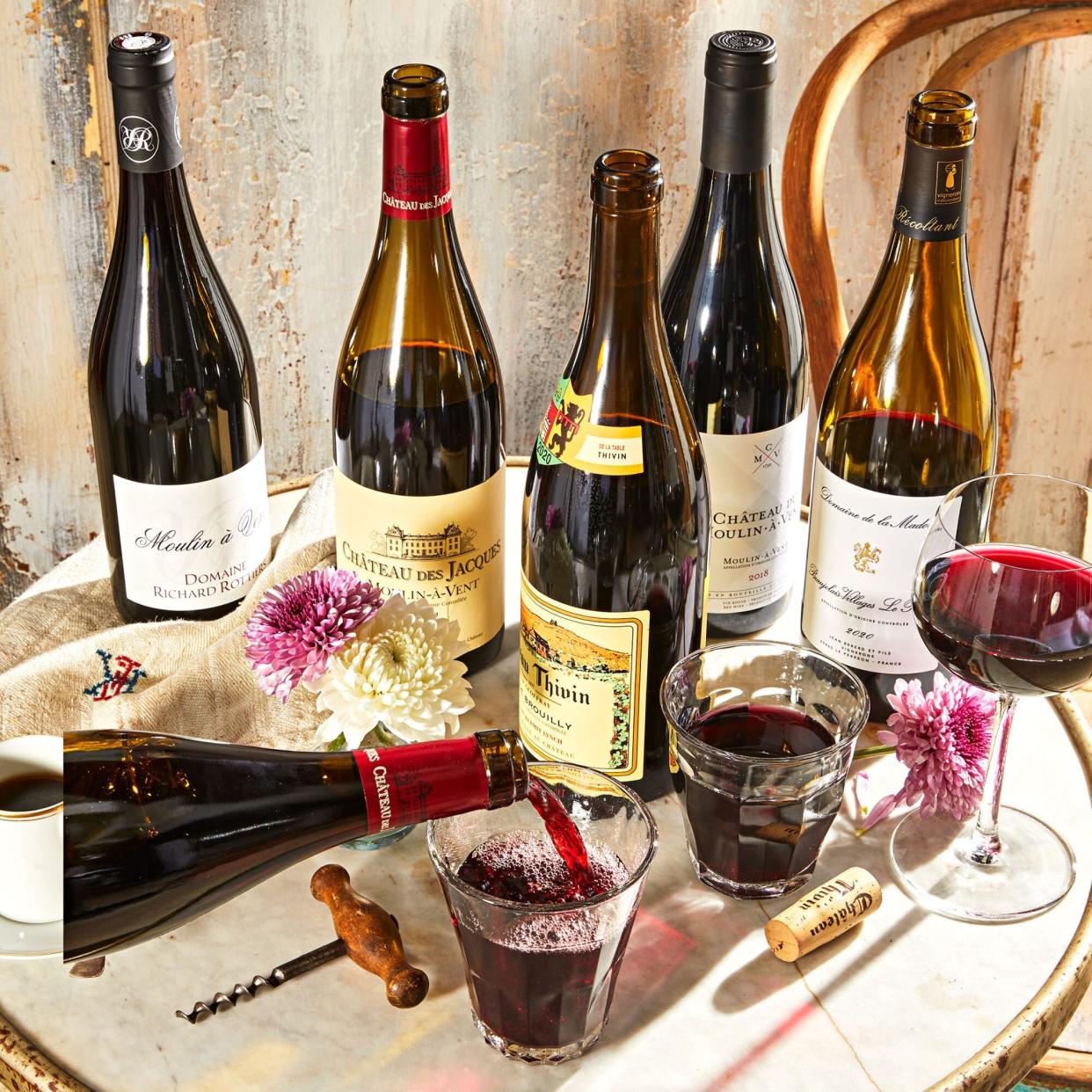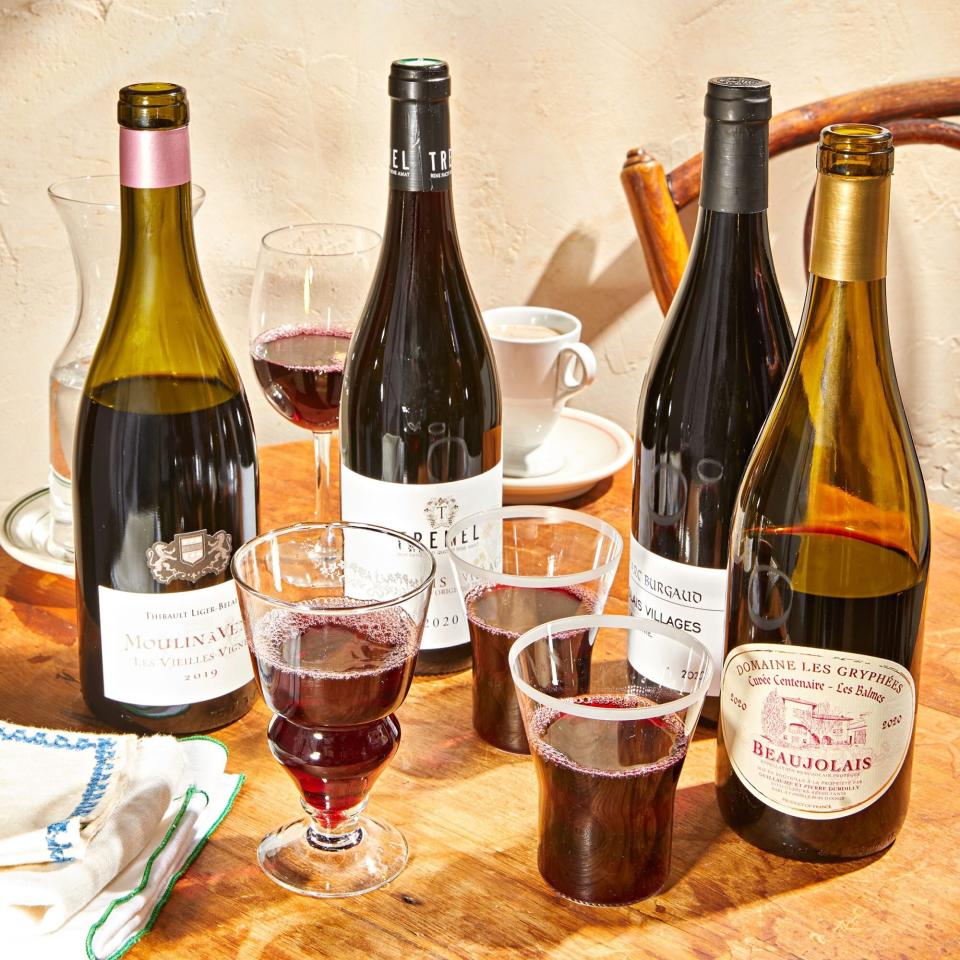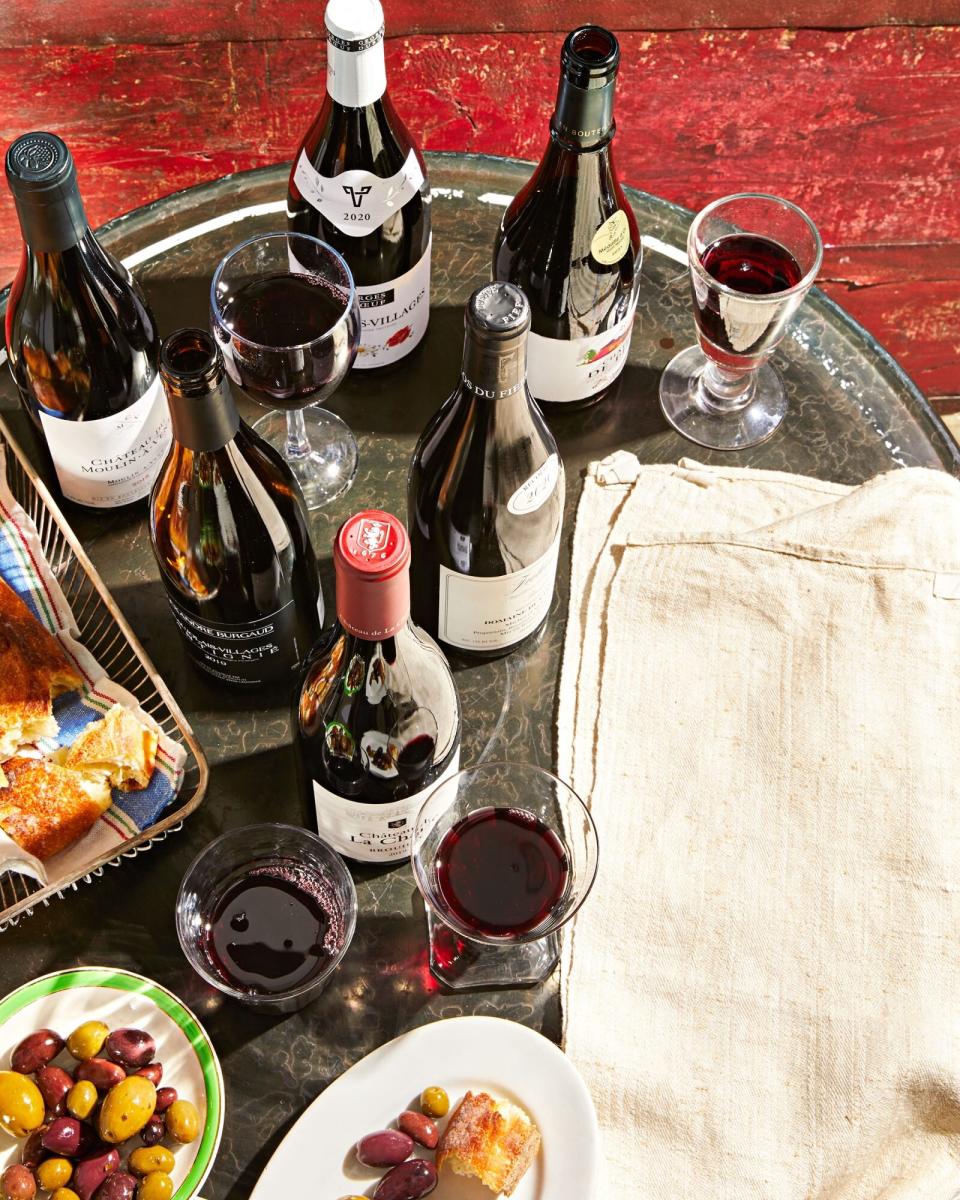There's More to Beaujolais Than You Think

Photo by Jennifer Causey / Food Styling by Chelsea Zimmer / Prop Styling by Lydia Pursell
Everybody's a critic. Back in 1395, Philip the Bold banned the Gamay grape from Burgundy, proclaiming it low and crappy (well, technically, "très mauvais et très desloyaus," or evil and disloyal). For growers in nearby Beaujolais, who were quite fond of Gamay, this was a bit like when your older brother puts a Magic Marker sign on his bedroom door saying, "Come in here, and you die." But Philip's dismissal had its effect, and for centuries, as red Burgundy garnered its nigh-unto-holy reputation, Beaujolais was confined to being, you know, fun.
Fine. As far as I'm concerned, Mr. Philip I'm-So-Bold can sit around all he wants in his castle, issuing proclamations and glowering at the walls. Personally, I'm pro-fun, and for me, basic Beaujolais and Beaujolais-Villages wines are the ultimate summertime reds, perfect for picnics and pools, great with a chill, vivid with red berry and spice flavors, and — absolute truth — far more interesting than 90% of the dry rosés out there.
Plus, cru Beaujolais, which comes from the ten top villages of the region, offers more still. These are complex reds that retain a touch of casualness even as they achieve remarkable complexity and depth. But maybe Thibault Liger-Belair, who makes impressive wines in both Burgundy and Moulin-à-Vent in Beaujolais, sums it up best: "When I finished my studies in 1996 in Beaujolais, I rented an old house in the vineyards, and I saw how beautiful it was every morning when I opened the window. And I decided that land that beautiful couldn't possibly produce bad wine."
14 Bottles of Beaujolais to Try

Photo by Jennifer Causey / Food Styling by Chelsea Zimmer / Prop Styling by Lydia Pursell
2020 Domaine Les Gryphées Beaujolais Cuvée Centenaire Les Balmes ($18)
Though this earthy, peppery red is labeled as simple Beaujolais, it comes from a small vineyard planted nearly a century ago. There's far more depth and complexity here than the humble designation would suggest.
2020 Domaine de la Madone Beaujolais-Villages Le Perréon ($15)
Olivier and Bruno Bererd, the brothers who farm the 100-year-old vines used for this light-bodied, bright, raspberry-scented wine, have to work by hand—their vineyards have such steep slopes that a tractor would tumble off the hillsides.
2020 Trénel Beaujolais-Villages ($19)
The négociant firm of Trénel, which was founded in 1928, produces both Burgundy and Beaujolais. But the standout value of their portfolio is this creamy and raspberry-rich Beaujolais-Villages, which uses fruit sourced from 38 villages around the region.
2019 Château du Moulin-à-Vent Moulin-à-Vent ($40)
Fragrant and spicy, with cherry and rhubarb flavors, this excellent Moulin-à-Vent comes from a domaine named for the 300-year-old stone windmill that gives the appellation its name. Also look for the estate's affordable Couvent des Thorins bottling–it's superb, too.
2020 Jean-Marc Burgaud Beaujolais-Villages les Vignes de Lantignié ($20)
Jean-Marc Burgaud has the majority of his vineyards in the cru of Morgon, but he also farms about 10 acres of vines surrounding a 12th-century château in Lantignié, outside the cru area, for this cuvée. It's full of lively wild-strawberry and pepper notes.
2020 Thibault Liger-Belair Moulin-à-Vent Les Vieilles Vignes ($23)
Deep raspberry notes and a creamy texture mark this refined cru Beaujolais, a blend of old-vine fruit from Thibault Liger-Belair's organically farmed estate. He also makes several terrific single-parcel wines, all worth tracking down.
2019 Château des Jacques Moulin-à-Vent ($28)
The fortunes of this historic estate were at a low ebb when the Burgundy firm of Louis Jadot purchased it in 1996. Since then, the wines have drastically improved; this polished Gamay, with its vivid purple hue, lingering berry flavors, and faint anise hints, is a case in point.
2020 Château Thivin Côte de Brouilly ($32)
Côte de Brouilly's vineyards cover the slopes of the long-ago-volcanic Mont Brouilly within the larger Brouilly appellation, and Thivin is undoubtedly the appellation's greatest producer. The 2020 is elegant and minerally, with blue plum and cherry notes.

Photo by Jennifer Causey / Food Styling by Chelsea Zimmer / Prop Styling by Lydia Pursell
2018 Domaine Richard Rottiers Moulin-à-Vent ($35)
Richard Rottiers is one of the up-and-coming young talents of Beaujolais, farming his small domaine in Moulin-à-Vent organically since 2012. The old vines there make a rich, layered red, full of black cherry flavor, that's impossible to resist.
2020 Georges Duboeuf Beaujolais-Villages ($18)
It's impossible to think of Beaujolais without thinking of Georges Duboeuf, who started the craze for Beaujolais Nouveau back in the 1980s. He passed away in 2020, but his widely available Beaujolais-Villages continues: juicy, red-berried, inarguably quaffable.
2020 Alexandre Burgaud Beaujolais-Lantignié ($25)
Although winemaker Alexandre Burgaud only got his start in 2013, he has rapidly become a talent to follow in Beaujolais. This spicy, blue-blackberry cuvée comes from a small vineyard in the village of Lantignié, which is often cited as deserving of cru status.
2020 Château de Pizay Beaujolais ($17)
Vineyards around this 14th-century château have been producing wine since medieval times. The property's basic Beaujolais is a superb value, with fresh strawberry-cranberry fruit and a soft texture. With a light chill, it's ideal for outdoor summertime quaffing.
2019 Château de La Chaize Brouilly ($23)
Brouilly, the southernmost and largest cru in Beaujolais, tends to make light, red-fruited, floral wines, the perfect type of red for when the weather is hot. This one, from an estate that's been farmed by the same family for the past 350 years, is a classic example.
2020 Domaine du Clos du Fief Tradition Juliénas ($23)
The granite hills of Juliénas make for spicy, dark cru Beaujolais, in this instance laced with light herbal notes. The Tête family has been farming this property for four generations; their savory, nuanced wines are benchmarks.

